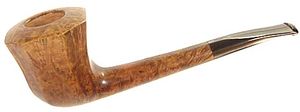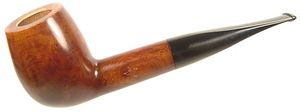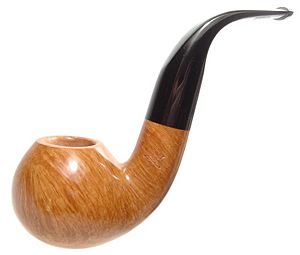West
Tim West collectors, please dive in


Tim made his first pipe in 1967 and went full-time as a pipe maker in 1975. Only the best quality fully cured natural Greek Briar goes into a Tim West Briar Pipe. Tim's designer shapes are designed for eye appeal and a great smoke. All processes, step by step, are natural processes insuring a sweet cool smoke for every recipient of a Tim West Briar Pipe.
Tim West Pipes are available at SmokersHaven.com

The following article originally appeared in the Profiles of American Pipe Makers series in the December 1995 issue of The Pipe Collector, the official newsletter of the American Society of Pipe Collectors (NASPC), and is used by permission. It's a great organization--consider joining.
[Keep in mind this material is dated yet it is included as it tells the history and sets up Tim's present day work-- Pipedia SYSOP]
Profiles of American Pipe Makers: Tim West
The Artisan
I met with Tim West on a cold November afternoon during his lunch hour at his suburban home in Northwest Columbus. He lives there with his wife, Carla, an RN on the orthopedic ward at Riverside Hospital, and three school-age children. A fourth child is grown and out of the house. The pre-Christmas season is a busy time for Tim, and he was engaged in shipping pipes to the 35 retail outlets that carry them. Tim and I settled onto a living room couch, and I set up my tape recorder on a coffee table. But I had to be careful to keep my mind on the interview and off the dozens and dozens of large and extremely tempting pipes (I wanted to hold and fondle all of them) that were spread across the floor and piled up on tables and chairs.
Tim's father, who died in 1960 when Tim was 10, was a carpenter who built and sold custom homes. The family lived in each new house until the next one was built and the last one sold. So Tim's childhood was spent living a nomadic existence in a succession of brand-new houses around Franklin County. But he learned from his father a good sense of tools and woodworking by accompanying him to job sites and building things out of scrap wood.
When he was 17 and in high school, Tim began smoking a pipe and got interested in the extensive pipe collection of Charles Ormerod, the father of a longtime friend. The collection featured many sculpted and unusually shaped pipes. Like most pipe smokers in those days, novice and veteran, Tim became a regular at Smoker's Haven, with its huge stock of GBDs and Charatans, where, he says, he "would walk around in awe and drool all over the cases."
But he couldn't afford them, and one day Sid Ritter of Smoker's Haven offered him a block of wood and a couple of stems and asked if he was good with his hands. Having faith in his own competence, Tim took the briar home, whereupon he caught some kind of bug. He wasn't very sick, hut he was contagious and couldn't go to school. So he descended into his basement and worked on the pipe, for a solid week, using only the very basic workbench hand tools available to him. The result was a skull's head pipe. He got lots of compliments for the pipe and proceeded to produce two more--a human hand holding a bowl and a clown's head with hat serving as a windscreen. He made a few more pipes in standard shapes, but then he entered Ohio State as an art student, started working, got married and drifted away from pipemaking. (Tim till has the second and third pipes he made, bt the skull was stolen the first week he moved into Monkey's Retreat.)
And drifted into music as the bassist for the rock band Bootleg, which was "fairly popular" around the Ohio State area for about three years, but at that time there were no good venues in Columbus that highlighted local bands. All that changed when the Agora opened in September, 1975--one month after Bootleg broke up. Another local band, McGuffy Lane whose music was quite similar to Bootleg's, wne on to become successful. So, but for a small timing glitch, we might be talking about Tim West, rock star, today instead of Tim West, pipe maker.
Jobless, bandless and single again in the fall of 1975, Tim went back to making pipes as a founding member of an artist's collective located in Monkey's Retreat, an eclectic goods and whatever shop still located on North High St. in Columbus. He and the other craftsmen soon started going on the road together to craft shows, and Tim began selling enough pipes to have a successful little business. In 1990, the last full year he did shows, Tim traveled to 25 of them. Today his is down to just two or three a year.
In 1980, Tim opened Tim West Pipes, a retail shop in the Ohio Center near downtown Columbus. He closed the shop in 1991 and moved the entire business to his home workshop to concentrate on wholesaling. The workshop takes up most of the basement of his house, but it isn't very big--some tools, racks of briar blocks, cabinets full of stems and boxes of half-finished pipes. To this day, Tim believes that he is much less mechanized than most pipemakers he knows of. He does have a top turner and a frazer, byt they're not hooked up, and the top turner is his television stand.
Tim acknowledges that, as a pipemaker, he is entirely self-taught, having learned through trial and error. He believes that pipemakers who have had the chance to study pipemaking or to work with established pipemakers are lucky because 'it just mystified me for years wondering how they did it--while I was doing it." And though he does use some power equipment today to drill, shape, sand and buff, everything is still set up, guided and shaped by hand.
When I asked Tim about his philosophy of pipemakeing, he laughed for some time. We talked further about the changes in his pipemaking over the years, and he allowed as how, during his first year at Monkey's Retreat, a good 50 percent of his pipes were sculptured (piano pipes, toilet pipes, guitar pipes, etc.) because he had lots of time and could take a week to carve a pipe for someone. It might be his only sale for a week but would still provide enough cash to keep him in business. As his popularity grew, he needed to make more pipes and thus increasingly produced smooth shapes, either freehand or standard.
Tim has won his share of blue ribbons and various awards, but he doesn't think much about them and can't remember what they are. He's far more interested in making pipes and selling them to people who will smoke and appreciate them, but I should note that he received the best standard shape award at the 1983 PCI show.
Time works about 40 hours a week making pipes and doing repairs for various shops around the country. Recently his father-in-law, Jim Seman, has begun working with Tim, who says that Jim "is turning into a good pipemaker." Tim's free time is spent with family. He also like cooking and does most of the cooking around the house.
When I asked Tim if he is as excited now to be making pipes as he was 20 years ago, he didn't hesitate a second answering "oh, yeah." As for his own pipe smoking, Tim hasn't smoked anything but his own pipes for years. He smokes good-quality English blends, heavy on the Latakia, but has no particular favorites.
The Pipes
Today, Tim averages about 1,500 pipes a year. They tend to be medium large to big, with either a Lucite or vulcanite (hard rubber) stem. He does no sandblasting, but he does do needlepoint carving on some of the pipes. He continues to use the finest Grecian briar that he can obtain, although he notes that some good looking briar is starting to come out of Morocco that he might like to try some day. He fully air dries the wood for one year in his garage before using it. He employs no oil or other kids of curing processes.
A Tim West pipe will come in one of three alcohol-based aniline stains--a natural, a walnut and a dark or black walnut--with a Carnauba wax finish. He will use the Dunhill or European Red stain, but not often. "I guess I'm very influenced by GBDs and Charatans from my ealy days. Their naturals were their virgin quality--their flawless or nearly flawless grained pipes. So I teind to go with the natural color on pipes that are flawless. Maybe I shouldn't be saying this, because everybody will be thinking that my walnut pipes and my dark walnut pipes are the ones with the flaws. That's not necessarily true, but I don't think it's a secret either that pipemakers stain their pipes for a reason. They tend to stain because they're covering up or masking imperfections on the surface. Briar wood is not perfect. If it was, there wouldn't be the mystique about it there is. If every single briar pipe had the same grain, it would be like a piece of furniture. But since it's not and since it does have imperfections, that leads to perfect pipes. So what I consider to be a good-grained pipe tends to be a natural, virgin quality.
During his five years at Monkey's Retreat, Tim signed his pipes T.M. West, Ltd. Since then, they have all been signed TIMWEST in block letter (with the same tool). Tim has never dated his pipes. Why not? "I don't know. Maybe I'll start next year. I've been telling myself I'll start for five years." Tim's pipes range in price from $50 to $150. The most expensive pipe he has ever sold was $350. [Dated info, of course-- Pipedia SYSOP]
I find it a little difficult to pin down or describe a "typical" Time West pipe. Tim says, "What I call a freehand pipe is what most people would call a Ben Wade of Standard Danish in that it's got a rough top and a V-shaped bowl, pointed at the bottom and wider at the top. That would be my standard classic freehand shape." But even the more standard pipes have a little difference or a little extra something that makes them not quite a classic standard shape. Perhaps it's best to let Time have the last word on this issues: "You know what? I make Time West pipes, and whatever they are, they are."
However, as Tim notes, "It's not like I make a pipe and never make it again, and every pipe I ever make is always different. I work from Time West shape charts, and I have popular shapes I've created that retailers are buying from me every time they order. And I've got standard freehand shapes that I'll make over and over and over again. So half of my business may be from models I've made before and am making again, but then the other half are just new designs, new creations, whatever the shaper/sander creates." And, Tim adds, "Freehands across the country are coming back; they are most definitely coming back."
Over the last 15 years, much of Tim's pipemaking style has been influenced by James Vieth, a Columbus resident who has commissioned Tim to make many European billiard, Dublin, and bulldog shapes from Mr. Vieth's own designs. These have been lightweight pipes with "elegant length designed into each pipe, and all have used dark Dunhill-style stains. Many of Mr. Vieth's designs have included extra-long sterling silver bands, which traditionally give a pipe a black-tie, dressed-up look.
Tim West is essentially out of the retail business, so anyone interested in his pipes should first ask his or her pipe shop if it carries Tim West pipes--and if not, why not". However, Tim does do custom orders and duplications. If you send him a pipe, he can match its shape, grain and stem. He also has shape charts of pipes he has made and is making now that he will mail out.
You can write Tim West at 1588 Grayling Court, Columbus, OH 43235 or fax or phone him at 614-761-3465.
- You may also enjoy listening to Brian Levine's interview of Tim on the Pipes Magazine Radio Show
Contact information:
Tim West, Inc. / J. H. Lowe & Co. 1588 Grayling Ct. Columbus, OH 43235-5950 Telephone: 614-761-3465 Tel/Fax E-mail: mailto:info@jhlowe.com Website: J. H. Lowe